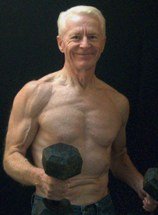| Back to Back Issues Page |
 |
|
The Gray Iron Fitness Newsletter, Issue #102, Build Bigger Arms with EDT training. November 15, 2012 |
Hi
November 15, 2012
In this newsletter . . . Build Bigger, Stronger Arms with EDT TrainingYounger seniors, especially, may like this workout and can expect tangible results. It is not for beginners, however. Beginners should first build a strength and fitness base (see: Beginning Weight Training). EDT stands for Escalating Density Training. I wish I could claim ownership, but it is not my creation. The great trainer/coach Charles Staley figured out this one. I’m paraphrasing now, but Staley explains EDT this way: Select a body part, let's say arms, and work them exclusively for 15 minutes. There’s nothing new in that, of course, but here's the rest of it: • You superset two opposing muscle group exercises. • For example, select a weight you can curl for 10 good, clean reps. Do the same for triceps extensions. • Use a stopwatch. For 15 minutes, superset the two exercises, doing 5 reps (not 10) in each set. If you reach a point where 5 reps are not possible, do 4 or 3. • Rest when you have to, but do as many sets as you can in 15 minutes. When you have finished, record your total reps for the 15-minute period. Now, here is the challenge: At each subsequent workout, keep doing sets of 5 reps with the same weight, but try to achieve a higher total during the 15-minute period. How do you do that? Your rest periods must get shorter. When you have gotten so you can do 20% more than your beginning workout total, increase the weight by 5% and start over. Anyone wanting to try EDT in its purest form should read Charles Staley's material. My adaptation is a little different, which I’ll explain in a moment. But either way, EDT is tough stuff, so the remainder of your workout should be designed for maintenance only. Use the 15-minute EDT period to really zero-in on one body part, in this case arms. In Staley's original, you rest 5 minutes after the first EDT session, and then do another 15 minutes, working the same body part but with a different exercise selection. My Adaptation One 15-minute period is enough for me, and I imagine it is enough for most people over 50. You want to really zero-in, but not overdo it. In my version, I did preacher curls alternated in superset fashion with seated triceps extensions. The pump was great and I experienced some rep/weight capacity improvement. Did my arms grow another half-inch as a result? No. That kind of increase would not be likely for someone my age (I was 66 at the time) with seven years of steady training behind me. Still, I had fun and was pleased with the modest gains. (Younger people with more growth potential on the same schedule should realize significant increases in strength and size.) The rest of my upper body workout was for maintenance. I worked this way once per week, and at my second resistance training during the same week, I did a maintenance only workout for my arms and the rest of my upper body. I did leg workouts on different days. I continued the program for six weeks. As mentioned before, I do not recommend EDT for beginners. Beginners should first develop a solid fitness base with a beginner’s program, such as the Gray Iron Fitness Guide for Senior Men and Women. But after that, experimenting with different training methods and programs makes all the sense in the world, and that’s when the fun really accelerates. Next newsletter (Dec. 1st), let's stay with arms again and I'll explain another specialty workout: Build Bigger Arms in a Day the Peary Rader way. I realize this sounds like an exaggeration. But Peary Rader was a solid guy, not one for hyperbole. I think you'll find it worthy.

You've probably heard about the tremendous benefits of weight training and how you can retain -- or even reclaim -- the attributes of youth . . . Discover the way with . . . Gray Iron: A Fitness Guide for Senior Men and Women
 Newsletter Policy The Gray Iron Fitness Newsletter is a free publication sent twice monthly to subscribers. The purpose is to provide honest and realistic fitness information for people age 50 and above. I have never been paid or received compensation of any kind to write a positive review or endorse a product. If I say that I personally use a product or service, it is because I find value in it and have paid for it with my own money. Like newspapers, magazines and television, this newsletter and my web site contain advertising and marketing links. Naturally, I am compensated for these. The newsletter and web site provide information to help users establish and maintain a fitness lifestyle. But fitness information is not the same as fitness advice, which is the application of exercise and dietary practices to an individual's specific circumstances. Therefore, always consult with your physician for assurance that fitness information, and your interpretation of it, is appropriate for you. Your comments and questions are always appreciated. Simply click on the "Reply" bottom. |
| Back to Back Issues Page |